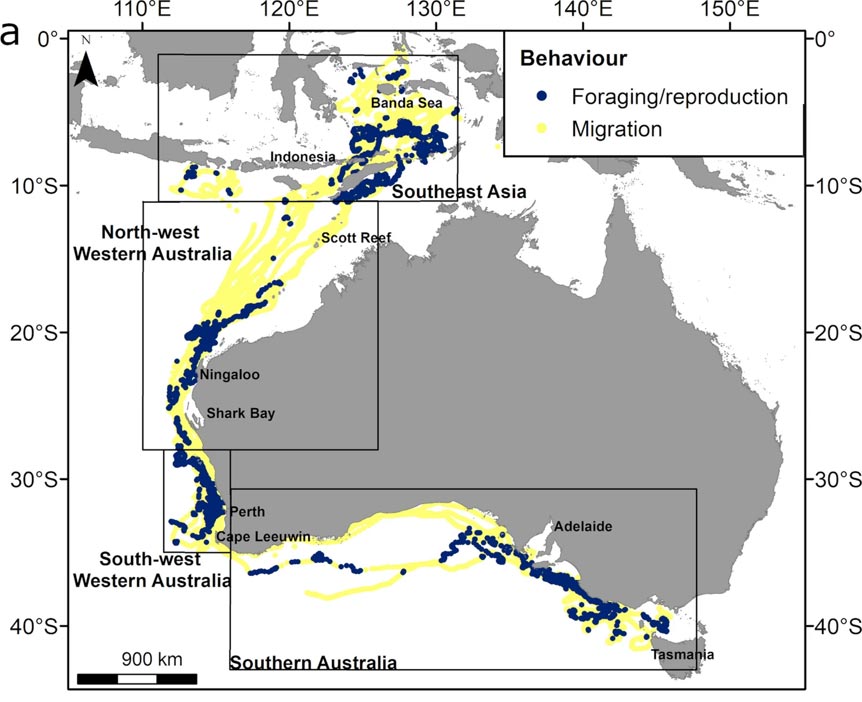← Back
Pygmy blue whales around Australia

Pygmy blue whales are migratory whales of the Southern hemisphere. Their migration leads them into areas where they can be threaten by anthropogenic activities. Argos satellite telemetry can help in their conservation management.
The Eastern Indian Ocean pygmy blue whale (Balaenoptera musculus brevicauda) is one of the two recognised blue whale subspecies in the Southern Hemisphere. They migrate from the Subtropical Convergence Zone and in southern Australian waters (austral summer feeding areas) to the equatorial region in the Banda Sea.
Their migration route crosses fisheries, offshore oil and gas activities, shipping routes and areas declared for offshore renewable energy developments; all anthropogenic activities that can expose them to threats. Blue whales are listed under Australian law as ‘Endangered’, and more information is needed to assist in their conservation management.
Tracking Pygmy blue whales
The satellite tracking data from 38 pygmy blue whales were included in an analysis by the Australian Institute of Marine Science, with 19 tags deployed in the Perth Canyon, Western Australia, 13 in the Bonney Coast Upwelling, South Australia, and 6 offshore of Ningaloo Reef, Western Australia (existing and new deployments).
A movement model was then applied to the raw Argos and GPS location data and machine learning methods and spatial predictions were used to evaluate the relationship between whale presence and environmental variables, to identify their probability of occurrence, and define habitat suitability. Low move persistence obtained from the movement model was considered as indicating foraging, rest or reproduction, while high move persistence indicated migratory movements.


Modelled satellite tracks of 38 pygmy blue whales and the boundaries of the four regions for which habitat modelling was undertaken, colour coded by behaviour classification in the top and by month of the year, overlayed with geomorphologic features in the bottom plot. (from [Ferreira et al., 2024])
Tagging took place at the start of or during the migration towards breeding areas in the Banda Sea (northbound migration) and the tracking data showed pygmy blue whales progressively moving along the coast of Australia. After passing Ningaloo, the tracks were more spread out.
Some whales crossed the abyssal plain while others followed the shelf break, reaching Indonesia and the Banda Sea in July-August. They stayed there until September–October. Only two of the whales provided data on the return trip.
Validated suitable habitat for foraging/reproduction (pink), foraging (dark red) and migration (light red), and satellite tracking data for eastern Indian Ocean pygmy blue whales. (from [Ferreira et al., 2024])
For all pygmy blue whale satellite tracking data combined, 33% of locations were classified as foraging or foraging/reproduction. Suitable foraging habitats were located almost exclusively on the slope (91% of suitable habitat) of the Australian continental margin, with a small percentage over deep ocean floor (7%) and minimally on the shelf except for southern Australia, thus making bathymetry the environmental parameter with the most predictive importance.
Some dynamic environmental variables (sea surface temperature, surface height anomaly and chlorophyll-a) also had a moderate to strong influence on probability of occurrence of whales. This suggests that suitability of habitats may change with the environmental conditions.
The outputs will help to better understand pygmy blue whale habitat use, and in turn to develop management strategies to assist in their conservation management. The studied sample of whales is still not very large, and data from more tagged whales are needed to better assess how habitat suitability varies temporally (seasonal, monthly).
Reference & links
Ferreira, L.C., Jenner, C., Jenner, M. et al. Predicting suitable habitats for foraging and migration in Eastern Indian Ocean pygmy blue whales from satellite tracking data. Mov Ecol 12, 42 (2024). https://doi.org/10.1186/s40462-024-00481-x
